Discover 25 hidden attractions, cool sights, and unusual things to do in Puerto Rico. Don't miss out on these must-see attractions: Castillo San Felipe del Morro (San Juan), La Fortaleza (San Juan) or Plaza Las Américas (San Juan).
Below, you can find the list of the most amazing places you should visit in Puerto Rico.
Table of Contents
Castillo San Felipe del Morro, San Juan
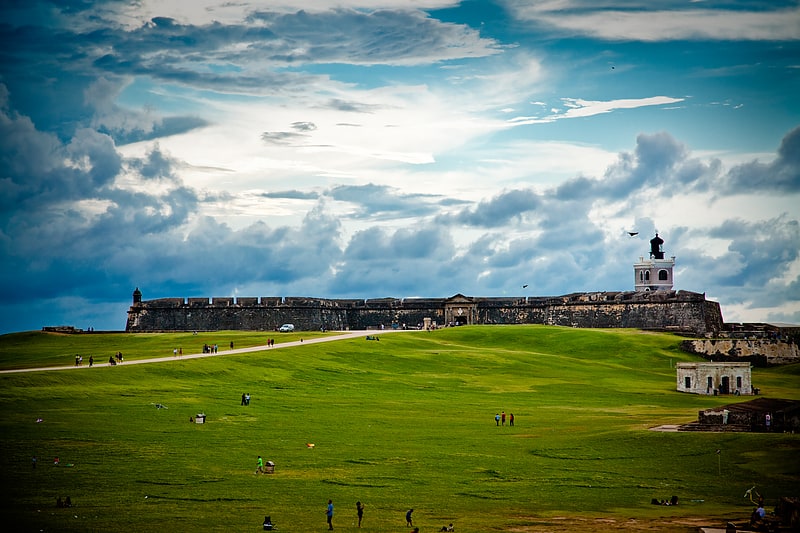
16th-century citadel built by Spanish. Castillo San Felipe del Morro, also known as El Morro, is a citadel built between 16th and 18th centuries in San Juan, Puerto Rico.[1]
Address: 501 Calle Norzagaray, 00901 San Juan
La Fortaleza, San Juan
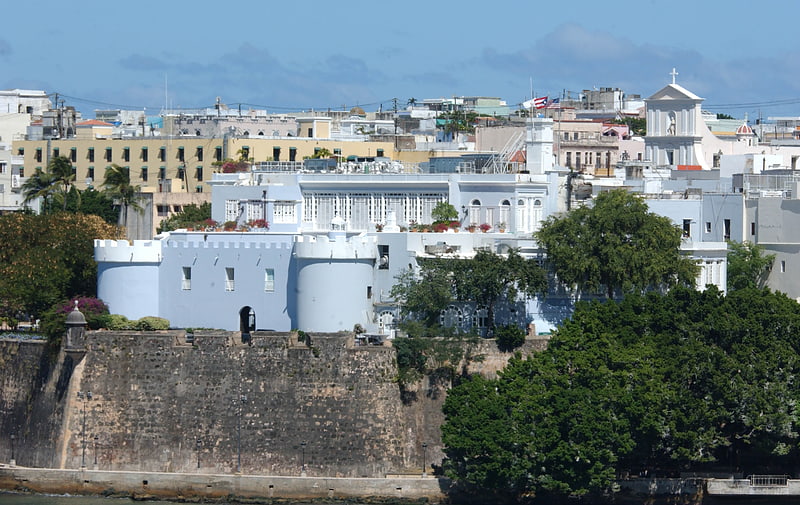
16th-century fortification and mansion. La Fortaleza is the official residence of the governor of Puerto Rico. It was built between 1533 and 1540 to defend the harbor of San Juan. The structure is also known as Palacio de Santa Catalina. It is the oldest executive mansion in continuous use in the New World. It was listed by UNESCO in 1983 as part of the World Heritage Site "La Fortaleza and San Juan National Historic Site".
During the 1640 reconstruction, the chapel of Santa Catalina, which originally stood outside the walls, was integrated into the walls of the structure, resulting in the alternate name Santa Catalina's Castle.[2]
Address: La Fortaleza, 00901 San Juan
Plaza Las Américas, San Juan
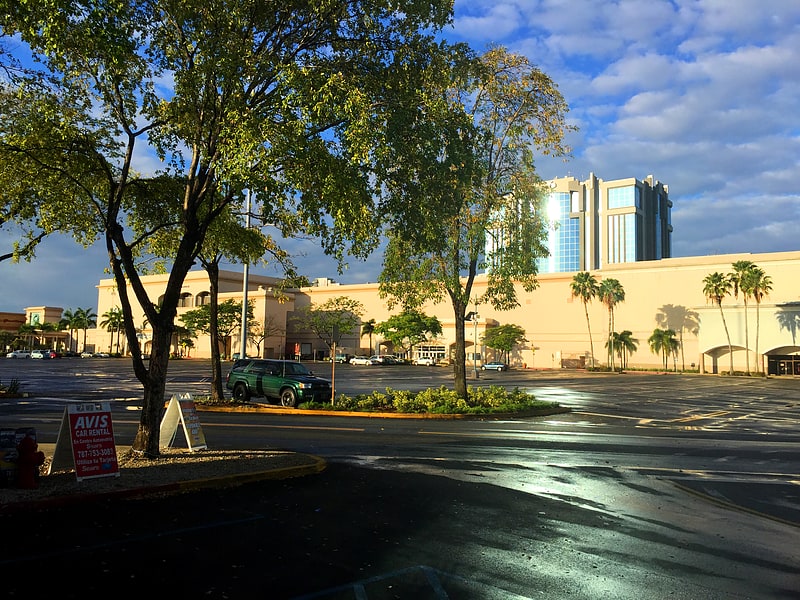
Shopping mall in San Juan, Puerto Rico. Plaza Las Américas is a shopping mall in Hato Rey, San Juan, Puerto Rico, located at the intersection of Routes 18 and 22. "Plaza", as it is known to many Puerto Ricans, was the first indoor shopping mall built in Puerto Rico. It is the largest shopping mall in the Caribbean and the second largest in Latin America. Anchor stores are JCPenney, Macy's, Sears, Sears Brand Central, Forever 21, Old Navy, Caribbean Cinemas and Marshalls. Cuba Libre and Macy's Backstage are coming soon to the mall.[3]
Address: 525 F.D. Roosevelt Ave, 00918 San Juan
Museo de Arte de Ponce, Ponce
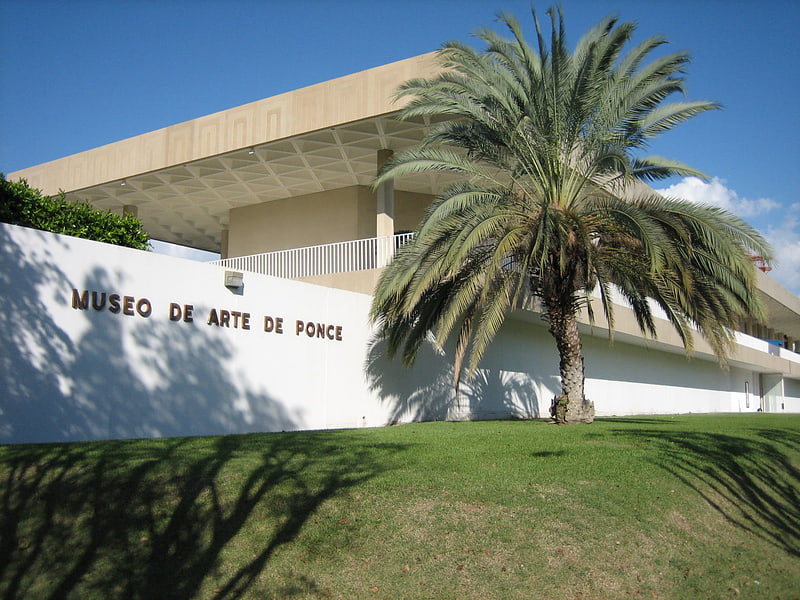
Major museum of art. Museo de Arte de Ponce is an art museum located on Avenida Las Américas in Ponce, Puerto Rico. It houses a collection of European art, as well as works by Puerto Rican artists. The museum contains one of the most important Pre-Raphaelite collections in the Western Hemisphere, holding some 4,500 pieces of art distributed among fourteen galleries.
Museo de Arte de Ponce is the finest art museum in Puerto Rico. The largest art museum in the Caribbean, it has also been called one of the best in the Americas. It was the first museum in Puerto Rico accredited by the American Alliance of Museums.
It was founded in 1959 by industrialist and philanthropist Luis A. Ferré at a location in the Ponce Historic Zone. The museum moved to its current building location on Avenida Las Américas in 1965. In 2010, the museum increased its size significantly after a $30M expansion.[4]
Address: 2325 Ave. Las Americas, 00717 Ponce
Centro Ceremonial Indígena de Tibes, Ponce
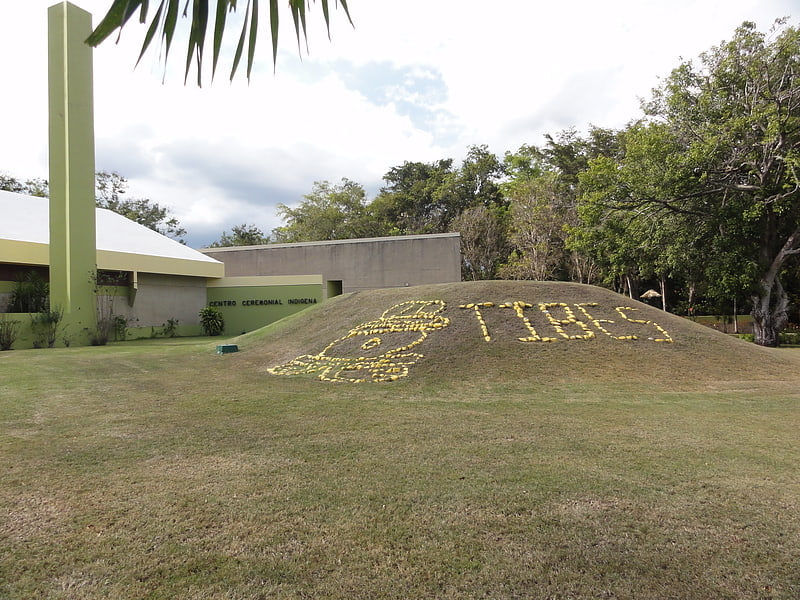
Pre-Columbian archaeological site. The Tibes Indigenous Ceremonial Center in Barrio Tibes, Ponce municipality, Puerto Rico, houses one of the most important archaeological discoveries made in the Antilles. The discovery provides an insight as to how the indigenous tribes of the Igneri and Taínos lived and played during and before the arrival of Christopher Columbus to the New World. Tibes is the oldest Antillean Indian ceremonial and sports complex yet uncovered in Puerto Rico. Within its boundaries is also the largest indigenous cemetery discovered to date – consisting of 186 human skeletons, most from the Igneri and the rest from the pre-Taíno cultures. Based on the orientation of the ceremonial plazas, this is also believed to be the oldest astronomical observatory in the Antilles. The museum was established in 1982 and restored in 1991.[5]
Address: Carr. PR-503, Km. 2.2, 00730 Ponce
Museo Castillo Serrallés, Ponce
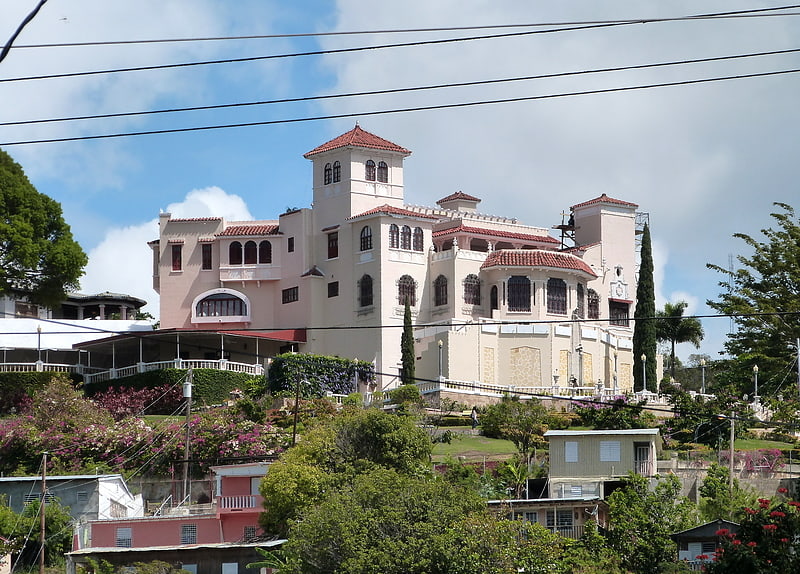
Museo Castillo Serrallés, a.k.a. Museo de la Caña y el Ron, is an agricultural museum in the city of Ponce, Puerto Rico, that showcases the history of sugar cane, its derivative rum industry, and their impact in the economy of Puerto Rico. The most notorious feature of the museum is the building it occupies. The building is a large four-story structure built in the 1930s for the owner of Ponce's Destileria Serralles, one of Puerto Rico's largest rum distilleries. The distillery was once also home to Puerto Rico's largest sugar-factory called Central Mercedita, producers of the Snow White sugar brand. The building, known as Castillo Serrallés, was designed by Pedro Adolfo de Castro in 1930 in the Spanish Colonial Revival style.
The museum sits on a 2.5-acre lot and opened on 20 February 1991. Visitors can tour the refurbished home, which has been furnished to appear as it did in the 1930s. There is also a temporary exhibit area for local artists. The Serrallés Castle is now part of a large complex that includes the Cruceta El Vigía, a Japanese Garden, and a butterfly garden (Mariposario). By September 2010, the museum was receiving around 100,000 visitors per year.[6]
Arecibo Observatory, Arecibo
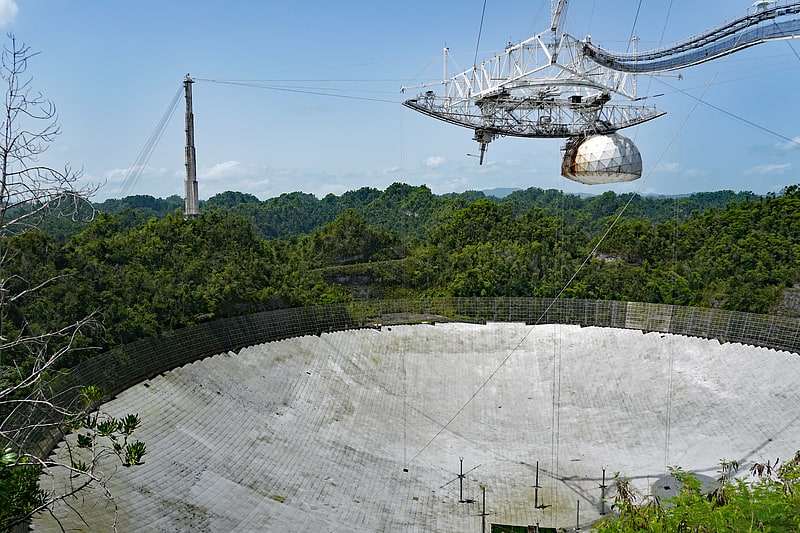
Observatory in Arecibo, Puerto Rico. The Arecibo Observatory, also known as the National Astronomy and Ionosphere Center and formerly known as the Arecibo Ionosphere Observatory, is an observatory in Barrio Esperanza, Arecibo, Puerto Rico owned by the US National Science Foundation.
The observatory's main instrument was the Arecibo Telescope, a 305 m (1,000 ft) spherical reflector dish built into a natural sinkhole, with a cable-mount steerable receiver and several radar transmitters for emitting signals mounted 150 m (492 ft) above the dish. Completed in 1963, it was the world's largest single-aperture telescope for 53 years, surpassed in July 2016 by the Five-hundred-meter Aperture Spherical Telescope (FAST) in China. Following two breaks in cables supporting the receiver platform in mid-2020, the NSF decommissioned the telescope. A partial collapse of the telescope occurred on December 1, 2020, before controlled demolition could be conducted. The remains of the telescope are being removed as NASA evaluates plans for a replacement instrument.
The observatory also includes a smaller radio telescope, a LIDAR facility, and a visitor center, which remain operational after the telescope's collapse.[7]
Address: 53995 Caja, 00612 Arecibo
Dr. Juan A. Rivero Zoo, Mayagüez
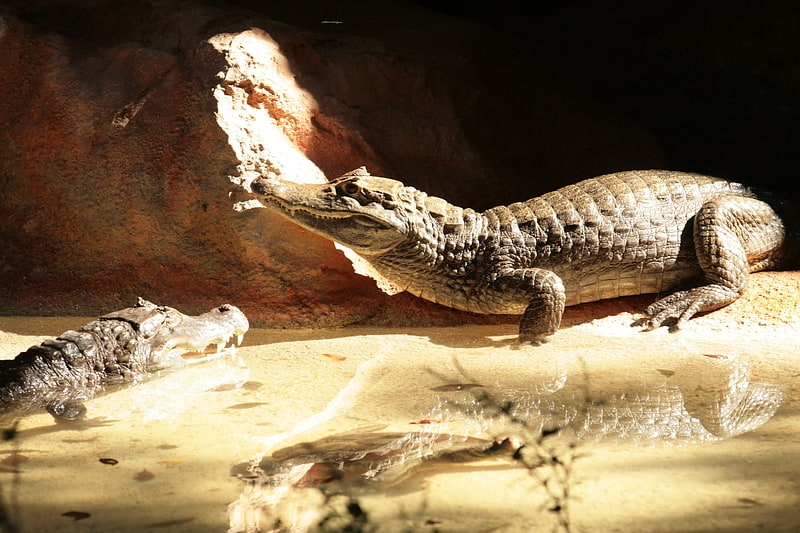
Traditional zoo plus insects and birds. Dr. Juan A. Rivero Zoo is a 45-acre zoo located in Mayagüez, Puerto Rico. It is the largest zoo on the island. It is named in honor of Juan A. Rivero, its first director. It has an extensive collection of animals from all continents. The premises of the zoo have remained closed to the general public following the passing of Hurricane Maria over Puerto Rico in September 2017.[8]
Arecibo Light, Arecibo
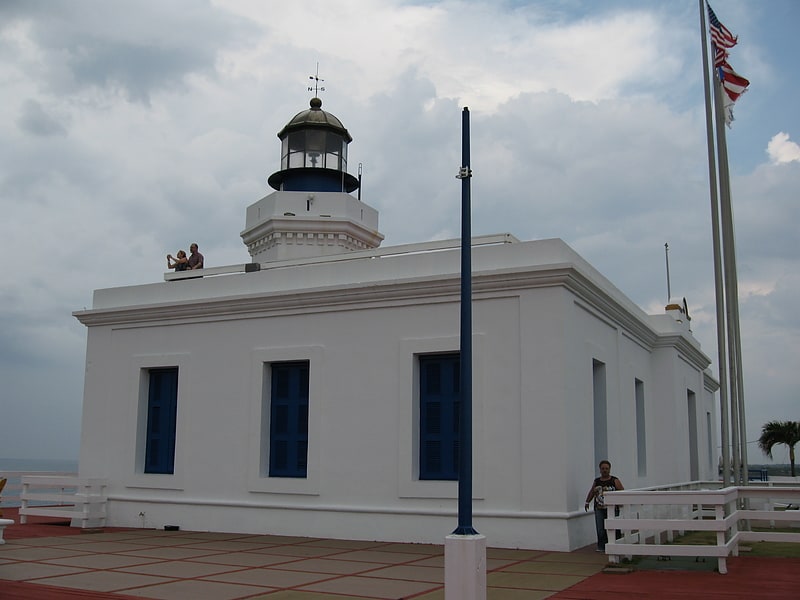
Lighthouse in Arecibo, Puerto Rico. Arecibo Light is a historic lighthouse located in the city of Arecibo, Puerto Rico. It is also known as Los Morrillos Lighthouse because of its location on top of a rocky headland known as Punta Morrillos. The lighthouse was constructed and was lit in 1898. This was the last lighthouse built by the Spanish government on the island.
The style of construction is neoclassical with a rectangular shape of 40 feet 4 inches (12.29 m) wide by 84 feet 2 inches (25.65 m) long, and has attached a hexagonal tower covered by a bronze dome with a working lantern. The original lens was a third-order Fresnel, with an 18-mile (29 km) radius. The lighthouse was converted to electric power in 1931. Currently, it has a 190 mm lens with a white flash every five seconds.
After the light was automated in 1964, the unmanned structure fell victim to decay and vandalism. The Fresnel lens was damaged in 1975 and destroyed in 1977.
A private company completed the restoration of the lighthouse in 2001. It has been operated as a foundation until the present. The lighthouse is called the Arecibo Lighthouse and Historical Park that includes a replica of a Taino Indian Village, a replica of the Niña, Pinta and Santa Maria, a Slavery Quarters, a replica of a Pirate Ship, a Pirate Cave, a Mini Zoo, various Salt Water Aquariums, a Playground, and a Water Park. The lighthouse is home to a small museum showcasing marine artifacts, the history of the lighthouse, and the Spanish–American War.
This lighthouse should not be confused with the Cabo Rojo lighthouse, known as Faro de Los Morrillos de Cabo Rojo.[9]
Address: Carr 655 Bo., Arecibo
Plaza Colón, Mayagüez
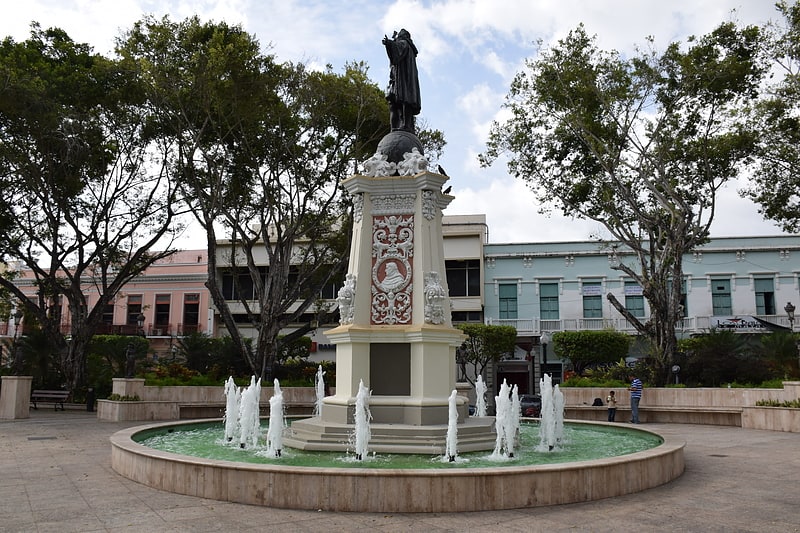
Park in Mayagüez, Puerto Rico. Plaza Colón is the main plaza in the city of Mayagüez, Puerto Rico. This plaza and its fountain commemorate the explorer Christopher Columbus, whose name in Spanish was Cristóbal Colón. The plaza presents the traditional urban relationship in Puerto Rico with the church, now Nuestra Señora de la Candelaria Cathedral on one end of the plaza and the "Alcaldia" or Mayagüez town hall in the other. Its location was designated in 1760 close to the city founding.
The plaza is paved in marble is graced by a group of lampposts in bronze that date over more than one hundred years. Each lamp is held by an oriental odalisque, including characteristic clothes, turbans, and veils. The plaza was designed after the Great Fire of 1841, approximately in 1842; years later, after being paved the plaza had a fountain in the center. The plaza has been remodeled several times including when Benjamin Cole was mayor and under the current mayor José Guillermo Rodríguez.[10]
Catedral Nuestra Señora de la Candelaria, Mayagüez
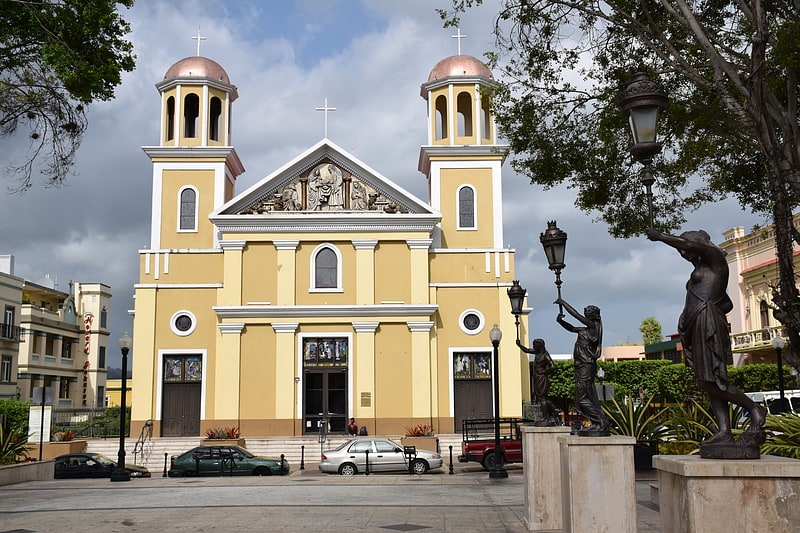
Catholic cathedral in Mayagüez, Puerto Rico. The Catedral Nuestra Señora de la Candelaria or in English, Our Lady of the Candelaria Cathedral, is the cathedral for the Roman Catholic Diocese of Mayagüez located in the eastern end of the Colón Main Square facing the town hall in Mayagüez, Puerto Rico.[11]
Address: 55 Calle Iglesia, 00680 Mayagüez
Isla Palomino, Fajardo
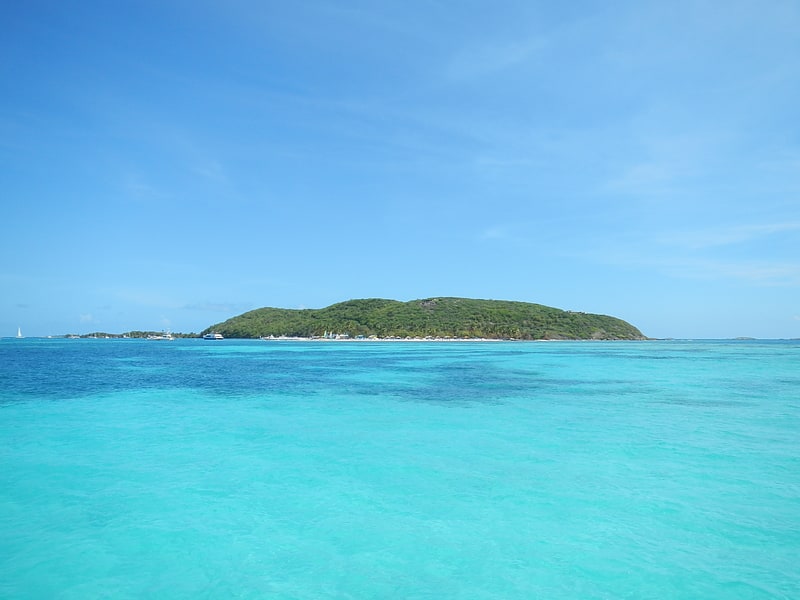
Island in Puerto Rico. Isla Palomino is a small, uninhabited island located to the east of Puerto Rico, near the coast of Las Croabas in Cabezas barrio, Fajardo.[12]
William Miranda Marín Botanical and Cultural Garden, Caguas
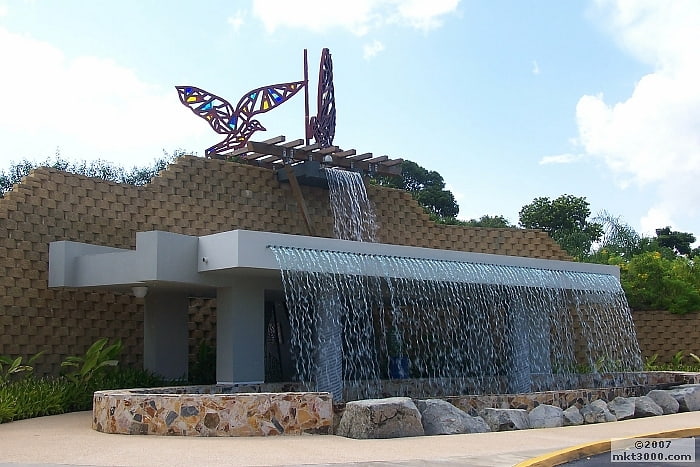
The William Miranda Marín Botanical and Cultural Garden also known as Botanical and Cultural Garden of Caguas is a botanical garden, archaeological site and natural reserve of about 235,800 m² of extension, which is located in the Cañabón neighborhood, of the autonomous municipality of Caguas, in Puerto Rico.[13]
Arecibo Telescope, Arecibo
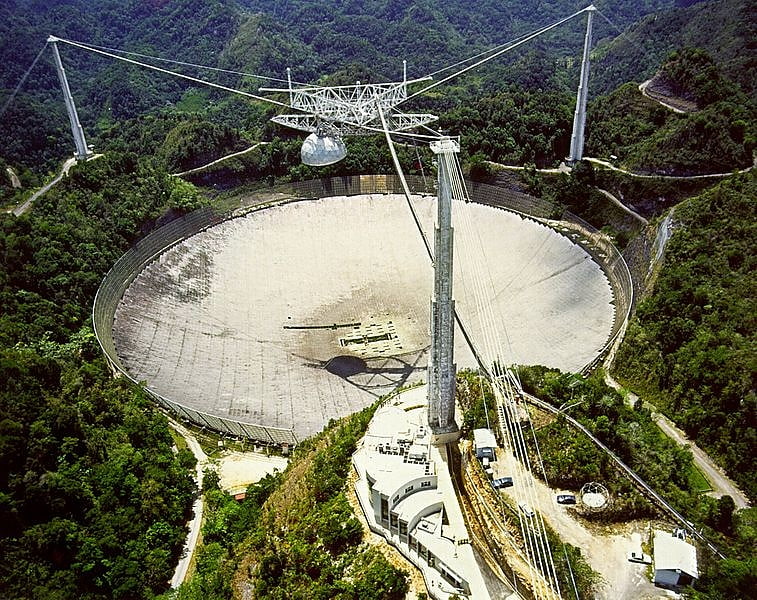
The Arecibo Telescope was a 305 m spherical reflector radio telescope built into a natural sinkhole at the Arecibo Observatory located near Arecibo, Puerto Rico. A cable-mount steerable receiver and several radar transmitters for emitting signals were mounted 150 m above the dish. Completed in November 1963, the Arecibo Telescope was the world's largest single-aperture telescope for 53 years, until it was surpassed in July 2016 by the Five-hundred-meter Aperture Spherical Telescope in Guizhou, China.
The Arecibo Telescope was primarily used for research in radio astronomy, atmospheric science, and radar astronomy, as well as for programs that search for extraterrestrial intelligence (SETI). Scientists wanting to use the observatory submitted proposals that were evaluated by independent scientific referees. NASA also used the telescope for near-Earth object detection programs. The observatory, funded primarily by the National Science Foundation (NSF) with partial support from NASA, was managed by Cornell University from its completion in 1963 until 2011, after which it was transferred to a partnership led by SRI International. In 2018, a consortium led by the University of Central Florida assumed operation of the facility.
The telescope's unique and futuristic design led to several appearances in film, gaming and television productions, such as for the climactic fight scene in the James Bond film GoldenEye (1995). It is one of the 116 pictures included in the Voyager Golden Record. It has been listed on the US National Register of Historic Places since 2008. The center was named an IEEE Milestone in 2001.
Since 2006, the NSF has reduced its funding commitment to the observatory, leading academics to push for additional funding support to continue its programs. The telescope was damaged by Hurricane Maria in 2017 and was affected by earthquakes in 2019 and 2020. Two cable breaks, one in August 2020 and a second in November 2020, threatened the structural integrity of the support structure for the suspended platform and damaged the dish. Due to uncertainty over the remaining strength of the other cables supporting the suspended structure, and the risk of collapse owing to further failures making repairs dangerous, the NSF announced on November 19, 2020, that the telescope would be decommissioned and dismantled, with the radio telescope and LIDAR facility remaining operational. Before it could be decommissioned, several of the remaining support cables suffered a critical failure and the support structure, antenna, and dome assembly all fell into the dish at 7:55 a.m. local time on December 1, 2020, destroying the telescope.[14]
Pozo de Jacinto, Isabela
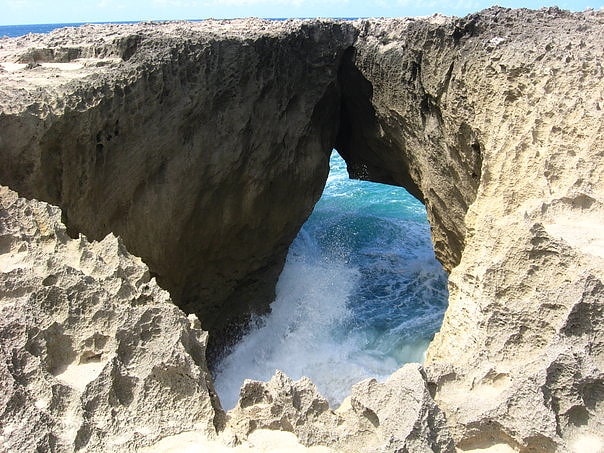
Historical place in Isabela, Puerto Rico. Pozo de Jacinto is a pit cave located at Jobos Beach in the northwestern side Puerto Rican municipality of Isabela on Puerto Rico Highway 466.[15]
Punta Borinquen Light, Aguadilla

Lighthouse in Borinquen, Puerto Rico. Punta Borinquen Light is a lighthouse located in the old Ramey Air Force Base in Aguadilla, Puerto Rico. The station was established in 1889 by the Spanish government. With the opening of the Panama Canal in 1914, the lighthouse would become "the most important aid to navigation on the route from Europe to Panama". In 1917, the U.S Congress provided funding for a new lighthouse in higher ground.
But before construction began on the new structure, the original lighthouse was severely damaged by the 1918 earthquake that struck the west part of the island. Construction on the new lighthouse was completed in 1922. The light is active aid to navigation and is a housing facility for the United States Coast Guard.[16]
El Yunque, El Yunque National Forest
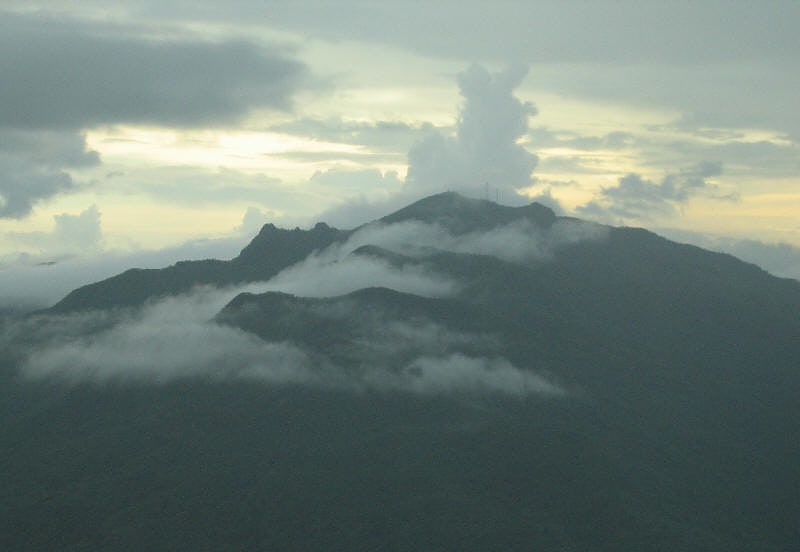
Mountain in Puerto Rico. Pico El Yunque or El Yunque Peak is a mountain that is located fully within the boundaries of the El Yunque National Forest, part of the U.S. Forest Service, which is the only tropical rainforest under the U.S. Forest Service jurisdiction. It is located in the municipality of Río Grande. The peak itself, standing at 1,080 metres above sea level is not the highest in Puerto Rico or even the Sierra de Luquillo range where it is located. It is however the most famous peak due to its curious shape, its natural environment and history, and for its cultural importance to the Taino people. The peak is nearly always covered in thin mist and, due to its high humidity, a quick shower develops during some afternoons. The hike to the top from the Mina Falls is not challenging yet it takes almost 4 and a half hours.
This peak is located on the El Yunque massif which also contains other smaller peaks such as Mount Britton, Juan Diego Peak and the Roca del Yunque which is a rocky peak close to the summit of El Yunque. El Yunque massif itself is part of the Sierra de Luquillo. The highest point in the Sierra de Luquillo is El Toro (Spanish for the bull) located in the municipal boundary between Río Grande and Las Piedras, which lends its name to the El Toro Wilderness.[17]
Jobos Beach, Isabela
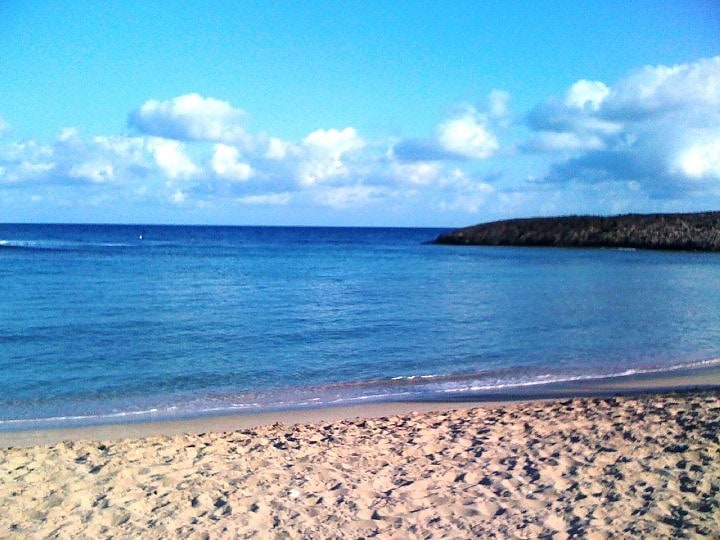
Beach in Isabela, Puerto Rico. Jobos Beach or Playa Jobos is a beach facing the Atlantic Ocean located on the PR-466 street of Isabela in the northwest of Puerto Rico. While popular, the beach is dangerous and signs warning tourists of dangerous currents were installed in early 2021.
Jobos Beach is known as a world-class surf spot and a good place to party. In February 2013, the beach hosted the Rip Curl Pro, a world tour surfing competition. Jobos is also a popular beach for windsurfing. Nearby, also in Isabela, is Pozo de Jacinto, a pit cave steeped in folklore.
The area near Jobos Beach suffered heavy damage from Hurricane Maria on September 20, 2017. The Tito Puente Amphitheatre reopened in mid-December 2017 with a concert by Circo, and other artists with Corona Fest x Nuestra Playas (Corona Fest for our Beaches) to raise funds for the clean-up at Jobos and other beaches in the area.
Jobos Beach in Isabela is considered a dangerous beach.[18]
Iglesia de San Antonio de Padua, Guayama
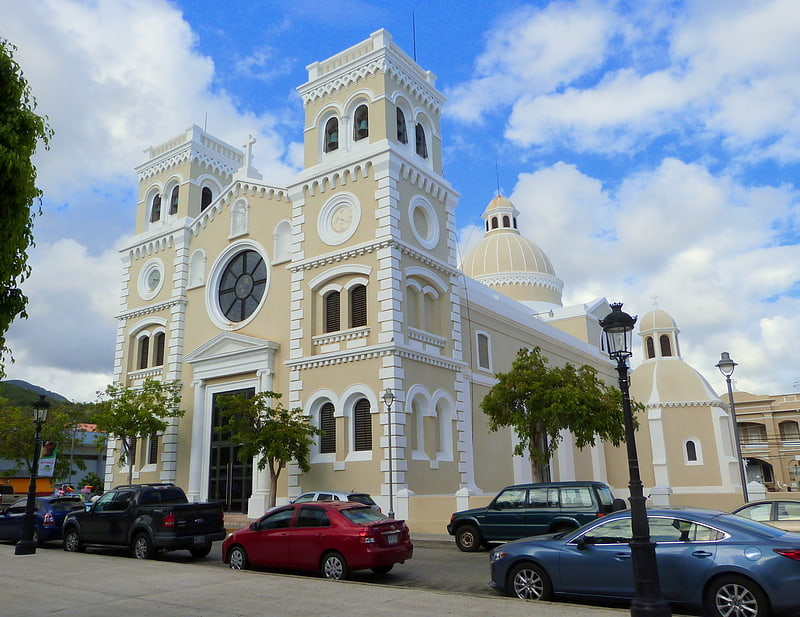
The Iglesia Parroquial de San Antonio de Padua is a historic, Roman Catholic parish church in Guayama, Puerto Rico. The parish was erected in 1736 and the first church building completed no later than 1775. The original appearance of the building is unknown, but some of the eighteenth century walls may survive in the present structure. The building was rebuilt twice in the nineteenth century and the present appearance dates from 1874. It takes an overall Romanesque form, while the details exhibit the eclecticism that characterized much Puerto Rican architecture in the later 1800s.
The church was inscribed on the National Register of Historic Places in 1976.[19]
Address: Calle Santiago Palmer, 00784 Guayama
Playa Icacos, Fajardo
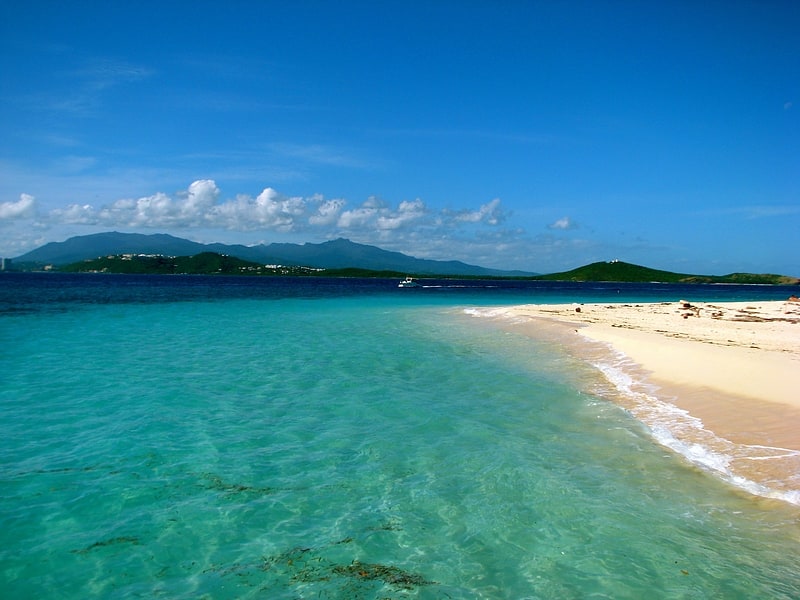
Island in Puerto Rico. Cayo Icacos is a small, uninhabited island off the coast of Fajardo, Puerto Rico. It forms part of the La Cordillera Reef Nature Reserve and is under the jurisdiction of the Department of Natural Resources and Environment. It is a fifteen-minute water taxi ride from Fajardo. The island is a popular snorkeling and beach tourism destination.
For some time, there was a limestone quarry on the southern part of the island, with a short railroad system to shuttle limestone from the quarry to the pier.[20]
El Parterre, Aguadilla

Park in Aguadilla Pueblo, Puerto Rico. El Parterre is a landscaped park in Aguadilla, Puerto Rico, that was built in 1851. The park encloses the Ojo de Agua, a natural spring which was a source of water for Spanish soldiers.
The park and spring were listed on the U.S. National Register of Historic Places in 1986.[21]
Crash Boat Beach, Aguadilla
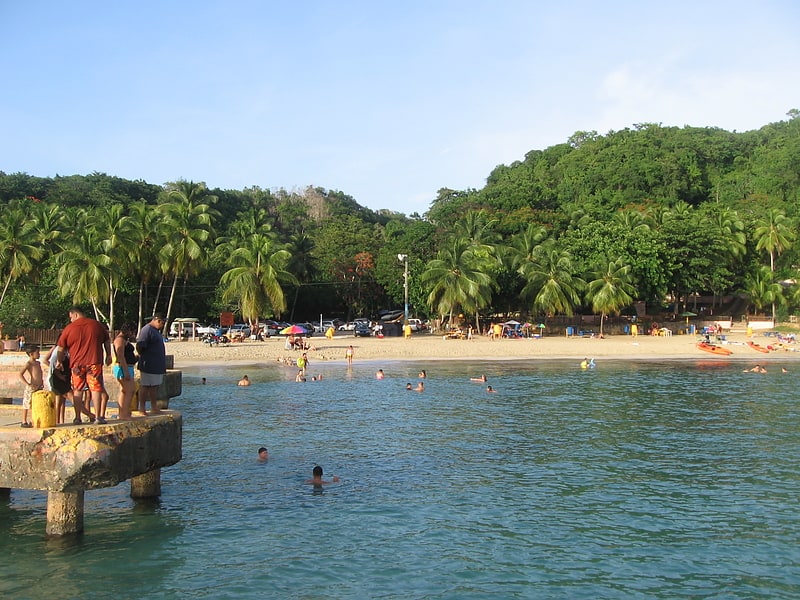
Beach in Borinquen, Puerto Rico. Crash Boat Beach or Crashboat Beach on the northwestern coast of Puerto Rico is situated in the municipality of Aguadilla.[22]
Edificio Alcaldia, Carolina
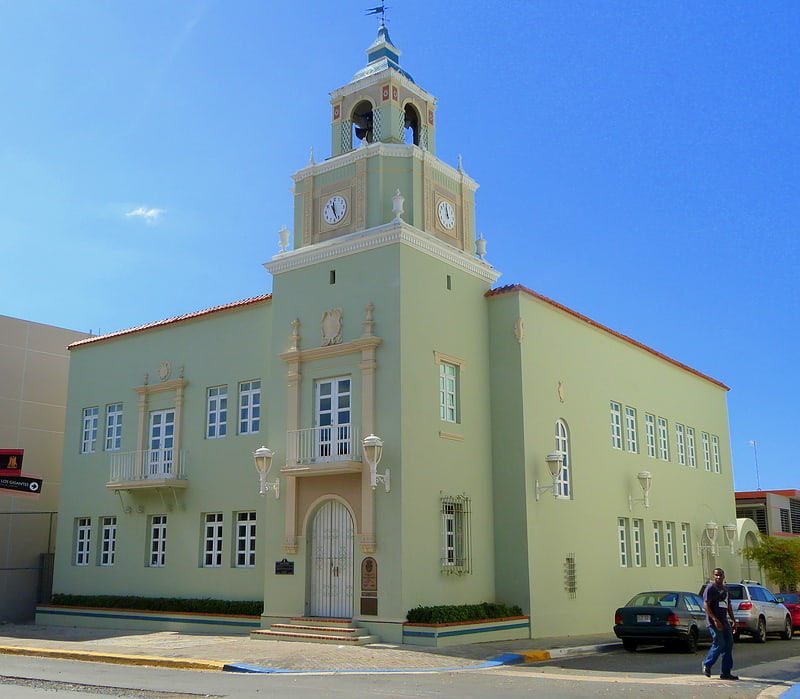
The Edificio Alcaldia is a historic building in Carolina, Puerto Rico. The building was designed by Puerto Rican architect Rafael Carmoega, then an architect of the Department of the Interior, with assistance of Francisco Garden. The Department of the Interior also built the building. In addition to serving as the City Hall, the facilities included government offices, the Municipal Jail, and a Medical Office.
It is a reinforced concrete and steel building, with bearing walls and major beams made of reinforced concrete. Joists for floors are steel. The building has a belltower with a small reinforced concrete cupola with Spanish ceramic tiles.
It was listed on the National Register of Historic Places in 1983. It was listed in part for its architecture, which is "in a style peculiar to the period in Puerto Rico. Reminiscent of traditional Spanish architecture, with motifs as varied as hanging moorish balconies on the one hand, and an austere Navarran portal on the other, the building is architecturally, one of the best in downtown Carolina."
The building was restored in 1992. It is currently the headquarters of the Cultural Development Program and the Tourism Office of the Municipality of Carolina. A new city hall was inaugurated in 1998.[23]
Palacete Los Moreau, Isabela
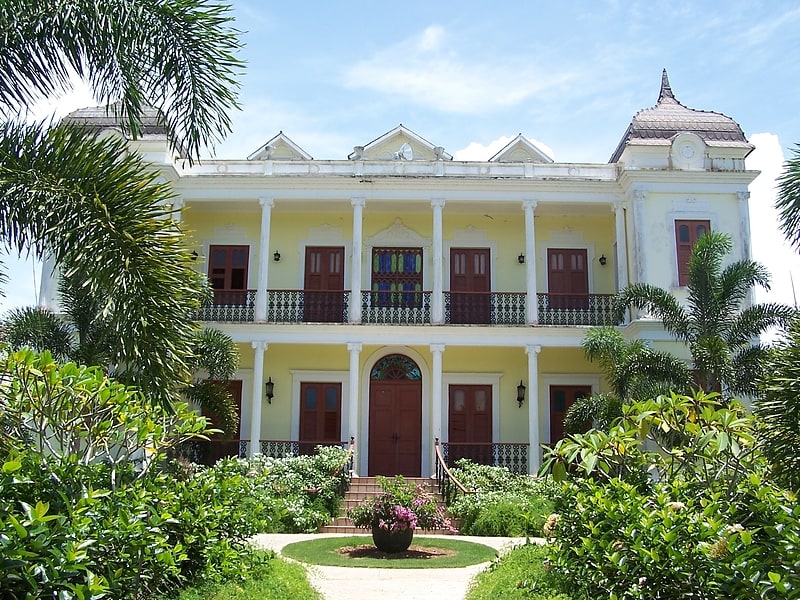
Historical place in Puerto Rico. Palacete Los Moreau is a house museum located in Moca, Puerto Rico. Historically known as the Labadie Mansion, the house inspired Enrique Laguerre to write La Llamarada. The property was restored as a museum and renamed the "Palacete Los Moreau" in honor of Laguerre's novel. It's listed on the National Register of Historic Places as Hacienda Iruena Manor House.[24]
Address: Carr. 464 Km 2.6 Interior, Isabela
Puerto Chico, Fajardo
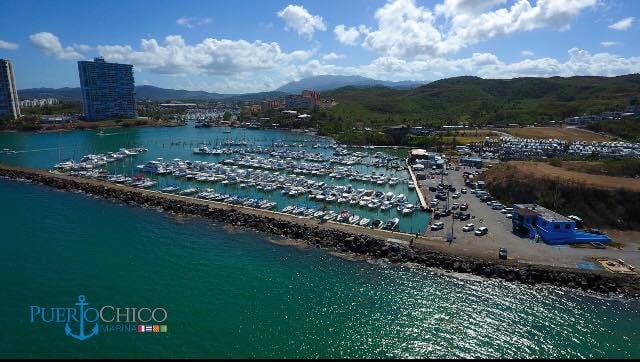
Sailing, Marina
Address: Carretera estatal 987, km 2.4, Bahía Sardinera, Fajardo